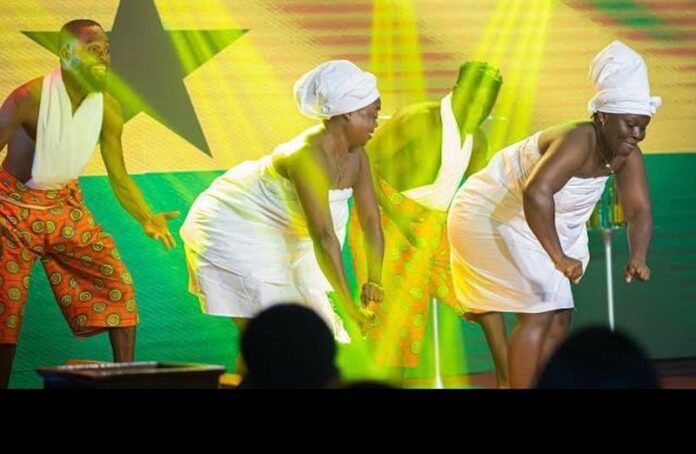Amid the warm dusk breeze of a Saturday evening in Accra, an extraordinary concert unfolded, celebrating the vibrant tapestry of Ghana’s musical heritage, spirituality, and culture. On an open-air stage framed by brightly lit palm trees and elegantly arranged tables, the atmosphere hummed with anticipation and reverence.
As the sun dipped below the horizon, guests gathered on lawn chairs and mats beneath a canopy of string lights near Osu. The event was billed as a fusion of gospel music and Ghanaian traditional folk rhythms—a bold blend of sacred praise and ancestral beats. Front and center were talking drums, kpanlogo, gyil (wooden xylophone), and shekeres, accompanied by a full live band of guitars, keyboards, and drums. Costumed drummers in kente cloth and adinkra-printed vests stood ready to bring the rhythms of Ga, Akan, and Ewe cultural dances to life.
The crowd erupted as Noble Nketsiah, the award-winning gospel artist celebrated for blending Ghanaian rhythms with worship music, took the stage. Flanked by the renowned Manklalo Cultural Group—a troupe of singers, drummers, dancers, and instrumentalists specializing in Ghana’s folk traditions—Nketsiah began softly with a worship song, his clear, resonant voice weaving through subtle background harmonies in Twi and Ga, interlaced with English refrains.
Gradually, the traditional percussion emerged: the pulsating kpanlogo beats of the Ga, deep Ewe drums, and northern kora melodies. Dancers adorned in colorful cloth and beads moved gracefully, performing steps from Ghanaian traditions such as Adowa, Kpanlogo, Agbadza, and Bamaya. Arms rose, feet stamped the earth, and cloth swirled in synchrony with the rhythms.
As the performance intensified, Noble raised his hands in praise while the band increased the tempo. The call-and-response vocals of the cultural group complemented the dancers’ energetic movements, merging gospel lyrics of hope and salvation with the ancestral heartbeat of Ghana. At one point, Noble stepped aside, joined the dancers for a short Adowa sequence, and returned to deliver a triumphant chorus.
The concert was structured as a musical journey: it began with gentle worship, transitioned into mid-tempo gospel-cultural fusion, and integrated Ghanaian dialects—Twi, Ga, and Ewe—into the lyrics, punctuated by traditional dances. The aim was to present Ghana’s musical heritage as living and breathing, not merely preserved in archives, but thriving in worship, celebration, and cultural expression.
In the second half, the tempo rose further. Electric guitar riffs layered over traditional patterns, while dancers performed with heightened energy, urging the audience to rise, clap, and participate. A highlight was a medley that began as a slow worship ballad and evolved into a full folk-music dance number, inviting audience members into a communal circle dance.
The event celebrated identity, showing that Ghana’s gospel music is enriched by its cultural roots. Traditional rhythms and dances were fully integrated into worship, not relegated to the margins. The outdoor setting under the open sky amplified the experience, making the fusion of spiritual melody and cultural rhythm feel expansive, freeing, and deeply Ghanaian.
From the first drum roll, the audience was engaged—standing, clapping, and dancing. Elderly guests nodded in recognition of familiar steps, while younger attendees recorded videos. When invited to join the dancers in a circle, guests from all walks of life moved together, following the rhythm of Adowa and Kpanlogo. Applause, cheers, smiles, and tears intertwined under the glow of the lights.
For the final song, Noble guided the band into a subdued mode while the cultural ensemble’s drumming swelled. He sang a final worship refrain in Twi, his voice soaring above the drums. The night concluded with a standing ovation, the performers holding hands and bowing as the crowd erupted with cheers and songs of “Aseda!” (Thank you).


